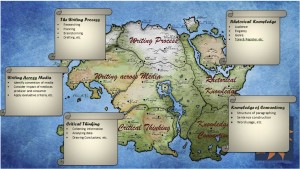Template for an “I am From” poemIAmFromTemplae
Template for Monica Hogan’s place poem (template created by Monica) Kansas is
Template for an “I am From” poemIAmFromTemplae
Template for Monica Hogan’s place poem (template created by Monica) Kansas is
Comments Off on Digital Storytelling Inservice materials
Posted in Uncategorized
 Pdf of handout & presentation slides F09–FitzpatrickHandout
Pdf of handout & presentation slides F09–FitzpatrickHandout
presentation slides: F09Fitzpatrick
session handout 4c14handout
Comments Off on Ignite & Play: Thinking in a Gaming Habit of Mind (2014 CCCC presentation, session F.09)
Posted in Uncategorized
“Like a welcome summer rain, humor may suddenly cleanse and cool the earth, the air and you.” – Langston Hughes
In the ENGL 292 Special Topics section “Humor and Literature,” students will investigating the role of the wit, jest and buffoonery in society; explore the cultural effects of gentle, broad and subversive comedy; and theorize about exactly what “funny” is. In this online class, students will engage with written and performed texts to study the elements that create humor as well as contemplate what it is that different instances of comedy reveal about the creator, audience and their culture.
Featuring:
Additional writings and performances by:
Comments Off on Coming Fall 2013
Posted in Uncategorized
Determiners: those silly little words that are so hard to define and, if English is not your first language in particular, can be so difficult to use correctly. Determiners are technically adjectives, but they contain so much hard-to-describe information they are often discussed as a class of words themselves
Determiners are a class of words that precede nouns and can indicate many things:
|
Types of determiners |
|||
|
|
Occurs with singular count nouns |
Occurs with plural count nouns |
Occurs with noncount* nouns |
| TYPE 1 |
yes |
yes |
yes |
| themy, his, her, etc.
no any what, which
|
the dogmy dog
any dog what dog
|
the dogsmy dogs
any dogs what dogs |
the milkmy milk
any milk what milk |
| TYPE 2 |
no |
yes |
Yes |
| no determinersome
enough
|
dog some dog enough dog |
dogs some dogs enough dogs |
milk some milk enough milk |
| TYPE 3 |
yes |
no |
Yes |
| this, that | this dog, that dog | this dogs, that dogs | this milk, that milk |
| TYPE 4 |
no |
yes |
No |
| these, those | these dog, those dog | these dogs, those dogs | these milk, those milk |
| TYPE 5 |
yes |
no |
No |
| a(n) each, every (n)either |
a dog, an eagleeach dog, every dog
either dog |
a dogs, an eagleseach dogs, every dogs
neither dogs |
a milk each milk, every milk either milk |
*a noncount count is a noun that is both singular and plural at once (for example, furniture or milk); noncount nouns do not require a determiner: “We like milk” is allowed, but “We like dog” is not.
Comments Off on Determiner cheat sheet
Posted in Uncategorized
Comments Off on testing
Posted in Uncategorized
Chances are, if you went to elementary school before 1970 (or attended a Catholic school before 1985), you remember diagramming sentences. One by one, you would be called up to the board to have your skills and nerve tested. You’d be given a sentence, and all you’d have to do was dissect—right there, immediately, flawlessly—in front of a class full of your peers and the hovering teacher. A ritual of childhood that, it turns out, taught many children only one thing about grammar: to hate it.
However, if you are one of those diagramming-loving freaks, have a long-lost need to revisit sources of pain from your childhood, or just want to kill a few minutes trying to outsmart a computer, you might want to visit the online Kellogg-Reed Diagrammer at http://1aiway.com/nlp4net/services/enparser/
Because this is a computer and not an intelligent being, of course, the program is not difficult to stump. Sometimes failing to insert a comma after an introductory clause or putting too many “cleft” structures in a row (as in “There was a boy who sang”) will result in the message “Cannot find an utterance,” as though you have literally left it speechless. It has lax standards—it will diagram “She pinked the dress,” correctly guessing that “pink” is being used here as a verb, but it will not diagram “After the meeting, it slowly walked away.”
Most often, it will generate multiple potential diagrams for the user—this is a computer, after all. It doesn’t speak English, only binary. When I input the sentence “The boy cried until he finally fell asleep” the parsing program incorrectly identified “fell” as the main verb in its first two offerings; only on the third did it realize that “cried” was the actual beginning of the predicate. And even when the diagrammer gives you many choices, there is no guarantee that any of them are correct. For example, when I typed in “Once upon a time, there was a dragon knitting sweaters for stray dogs, and he opened a yarn store with his friend, a unicorn named Fred,” the website gave me a whopping 24 possible diagrams. None of them were quite right.
Comments Off on Sentence Diagramming & Computers
Posted in Uncategorized